DESCRIPTION
Advances in medicine have increased the likelihood of recovery following the onset of diseases such as stroke. Thus, it is essential to consider life after survival. Freedom in life is a key to enhancing the quality of life (QOL)—people who could not previously walk can now walk and enjoy their lives with freedom even though they are living with severe disabilities. Although such a scenario was nothing more than an impossible dream in the past, it has been progressively realized. Advanced technologies have turned an impossible dream into a reality. To develop new technologies, Professor Saitoh thinks through ideas and has continually released rehabilitation robots in which cutting-edge technologies have been materialized.
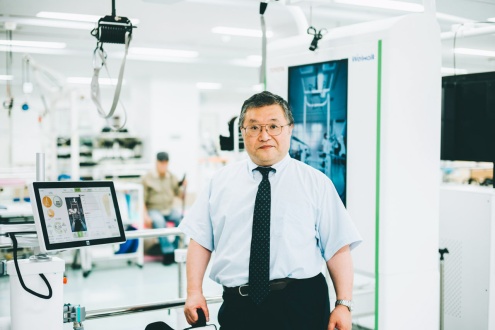
In response to a question on how existing rehabilitation robots should work, Professor Saitoh has developed an assistant robot that enables independent walking ability to be restored in patients.
Rehabilitation robots are experiencing a growing demand worldwide because rehabilitation markedly affects patients’ QOL. Furthermore, rehabilitation is indispensable for those who have survived a life-threatening illness so that they can be ready to return to their normal lives.
Professor Saitoh broached the topic, saying, “It is true that there has been significant improvement in AI and virtual reality technologies; however, real humans are living in a physical world, and they move in a physical manner. It is natural that people want to move freely when they physically move. The role of rehabilitation robots is to meet such needs.”
Presently, various rehabilitation robots are increasingly developed throughout the world in a competitive manner. A common type of robot in the United States and Europe is one that reads signals from the patients’ brain so that it can assist the patients in moving as they desire. This robot allows patients to move to a certain extent.
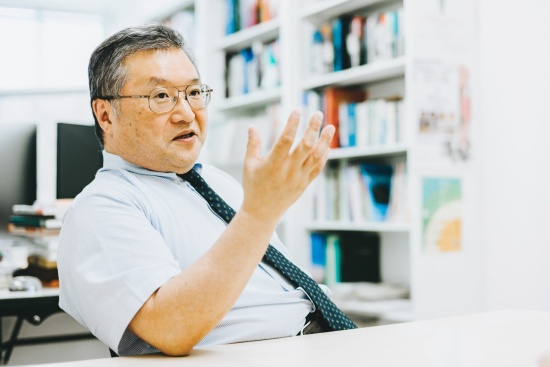
However, Professor Saitoh wonders if robots such as these are the only remaining method.
“Even if a patient is assisted by a robot, it would still be better if they could actually walk on their own. However, this is not my goal. What I would like to realize is for a patient who has been unable to walk to recover his/her walking ability. To achieve this goal, a robot that provides support for patients to recover their independent walking ability is needed.”
Conventionally, patients underwent walking rehabilitation training while being accompanied by a therapist; however, this method has an inherent issue, namely the “assistance paradox.”
As there is a limit to human reaction time, a therapist cannot stop a patient from falling if they start trying to catch the patient from the time at which they notice that the patient has lost balance. Thus, therapists would be required to support patients’ body all the time during training to prevent patients from falling. However, this results in patients depending on therapists and does not help them to regain balance; this is called the “assistance paradox,” and there is a limit to rehabilitation in which a human can assist patients.
Comprehending users’ needs on site and turning an impossible dream into reality through collaboration amongst industry, academia, and the government
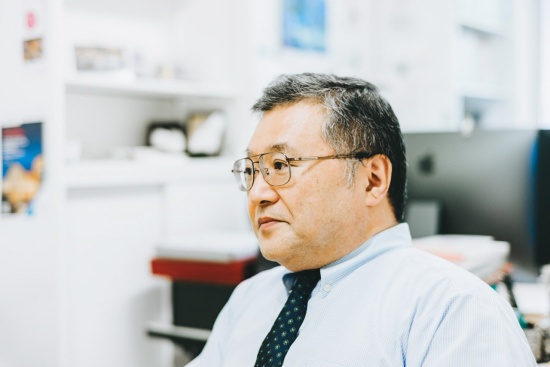
“We started developing an idea of using a robot in rehabilitation. While a human’s reaction time is 0.3 seconds, that of a robot is almost 0 seconds. Thus, if we use a robot to assist a patient undergoing rehabilitation, it can immediately respond when the patient starts to lose balance and is about to fall down, thereby preventing the patient from falling. Furthermore, because the patient is held by a robot instead of a therapist, the patient can learn how to maintain balance without being worried about falling onto a human. This rehabilitation assistance robot has been developed not based on a cutting-edge neuroscientific concept, which many researchers rely on, but upon the knowledge of traditional motion science.”
Outstanding results from rehabilitation in which the rehabilitation robot “Welwalk” was used have been presented with numerical data. The Welwalk robot was jointly developed by Professor Saitoh and Toyota Motor Corporation. With the assistance of Welwalk, the speed at which a patient recovers indoor walking has increased by up to 1.7-fold compared with that using conventional rehabilitation methods.
Professor Saitoh sees beyond this. Patients return to their everyday lives after completing rehabilitation at a hospital. However, Professor Saitoh reflects on what is needed to make the lives of patients better after they return to their everyday lives.
“In short, what I would like to provide is the “joy of life.” When I was working on supporting patients with dysphagia, I saw first-hand how they regained their ability to eat and appeared to be very happy. Therefore, I would like to help patients who cannot walk to walk again. I would also like to help people with severe disabilities live their lives in the way that they choose. It might be considered that this is an impossible dream, but I believe that this is achievable if we effectively use engineering technologies, which are rapidly advancing.”
An experiment in the Robotic Smart Home (RSH), a fusion of home, robot, and environment
Thinking along the same lines, Professor Saitoh is working on an experiment in the RSH, which is a fusion of the home, robot, and environment. The RSH has been set up in the Toyoake Danchi (apartment complex) near the university. The RSH is equipped with several devices and equipment, including a small robot that supports everyday life, a device that assists users in moving from the bed to the wheelchair, a walking assistance robot, and a video exercise system that use a teleconference system; these devices and equipment have been repeatedly upgraded as they are used by senior residents of the Toyoake Danchi.
“I have been developing the home environment and robots based on the concept of senior citizen-friendly design. This means installing devices and equipment at places where they should be not merely from a perspective of developers but from that of users, i.e., the needs of patients and their family. For example, a chair-type robot, which can move in any direction to make it easy for the user to move out of bed and move in the direction they want, moves in an unprecedented manner, such as horizontally. Through industry–academia collaboration, researchers come up with ideas and validate them, and manufacturing companies then apply the ideas to real objects. Impossible dreams can be turned into reality through this collaboration.”
Professor Saitoh is also a leading authority in the field of swallowing rehabilitation and has experience in developing the first computed tomography examination method for dysphagia in the world through industry–academia collaboration. He has been implementing unique development methods in which his expertise in the industry–academia collaboration is reflected.
The innovative spirit that underpins rehabilitation research at Fujita, with no fear for changes
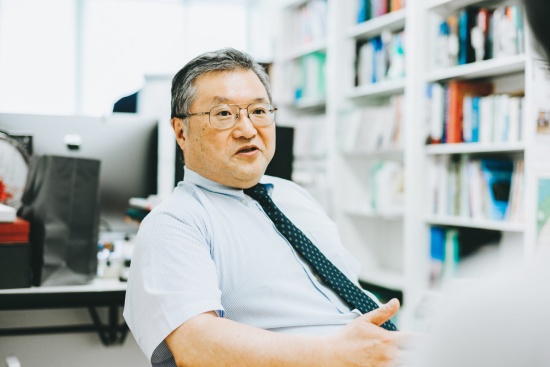
In 2004, Professor Saitoh demonstrated his initiative in establishing the Faculty of Rehabilitation (majors: physical therapy/occupational therapy), the School of Healthcare, Fujita Health University. Despite his achievement, when asked about the factors that made the Faculty of Rehabilitation a world-class facility, the professor humbly said that he was just lucky.
“I joined Fujita Health University as an assistant professor in 1995. At the time, rehabilitation at Fujita Health University was not at the first-class level that it currently is. That said, there was an atmosphere that encouraged us to implement any good measures that we came up with. In such a setting, I was asked to transform a hospital that was called the “Fujita Health University Nanakuri Sanatorium” at that time. I changed the hospital operations so that it would be focused on rehabilitation and implemented various measures that were different from existing ones. It is true that the measures were different; however, all we did was simply make progress on operations in line with the Japanese national health insurance scheme and in a way such that patients would benefit and operational costs would be reduced. These measures were operationally successful from the first fiscal year, and my contribution was recognized. Therefore, I obtained approval for setting up the Faculty of Rehabilitation within Fujita Health University.”
Physical therapists and occupational therapists who have studied at the Faculty of Rehabilitation will engage in training for developing basic practical skills in the university’s facilities after they graduate. Following an approximately 5-year training period, they will start working in the university’s affiliated hospitals as mid-career therapists.
“It is therapists that should take the lead at rehabilitation sites. For this, they are required to have skills that allow them to hold discussions with doctors at an equal level. Therefore, therapists need to continue learning at university hospitals even after graduation. Therapists with advanced skills will serve as leaders in team-based healthcare in affiliated hospitals,” Professor Saitoh emphasized the significance of therapists in rehabilitation. Such a talent development system is a crucial basis of rehabilitation at Fujita.
How can the QOL of people with dementia be enhanced going forward?
Professor Saitoh sees dementia as the next target. There is little time left before 2025, in which the generation of baby boomers starts turning 75 years. The dementia population in Japan is predicted to soar.
“While less than 10 years are left before 2025, we have been making steady progress on preparations. Unfortunately, today’s medicine cannot cure patients suffering from dementia. Therefore, we are aiming to make the lives of people with dementia as comfortable and pleasant as possible. Our specific goals are that patients should live comfortably and people who care for patients should feel happy. It is hard work to care for patients with dementia.”
The means to achieve the goals mentioned above are AI and robots. Predominantly, much is expected of AI. An AI system can be trained to learn the facial expressions of patients with dementia so that the system can augment its understanding of patients’ feelings. If an AI system can read the feelings of patients based on their facial expressions and what situations and activities make patients feel comfortable, patients could live in an environment where they are surrounded by things that make them feel comfortable. Furthermore, the RSH provides crucial opportunities for experiments conducted within research to develop into measures that address dementia.
To date, Professor Saitoh has made achievements in various areas, including the transformation of a rehabilitation facility, establishment of the Faculty of Rehabilitation, development of the first CT examination method in the world for the swallowing function, development of rehabilitation robots, and RSH and measures for addressing dementia.
Diligently working on multiple projects in parallel with an understanding that research takes time
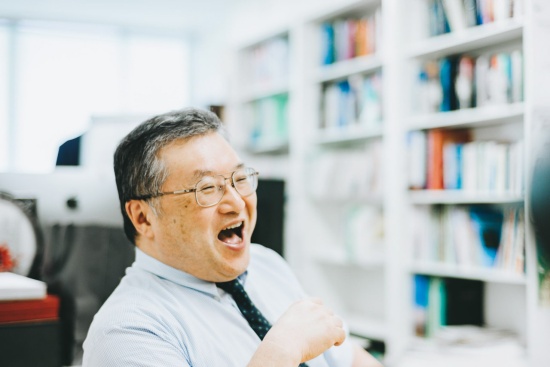
When asked about his secret for accomplishing significant results one after another, Professor Saitoh attributed his success to the Inchworm Theory. Briefly, it is imperative to comprehend that a research project is like an inchworm that can only move forward inch-by-inch and that there are times when progress stalls. Such an idea helps understanding that not everything moves forward without facing issues and avoiding frustration when things are not going as expected.
However, after spending a prolonged time with such inchworms, you will start noticing that the situation is changing. With a closer look, you can witness that some projects are actually moving forward. When a little progress is made, there is a new finding, which also encourages further research. Progress on research is never linear. Hence, it is imperative to occasionally wait while progress is being made.
“I had an experience in which after I stopped working on a research project for a while, I suddenly came up with a new idea that took me to the next step. Generally, most research projects take time to complete. It can take approximately 10 years for a single research project to generate a result. In addition, even if you come up with 100 ideas, only one of them might eventually be used. I continue to conduct research despite such a situation because I like to think of ways to make people happy. I continuously think, think, and think. I could not be any happier when I see my hard-thought ideas lead to the development of tools that help patients.”
Professor Saitoh always arrives at the office earlier than everyone else because he says that the morning is the best time for thinking. Today, as usual, he has probably been thinking from the early morning about how to make his next idea a reality.
